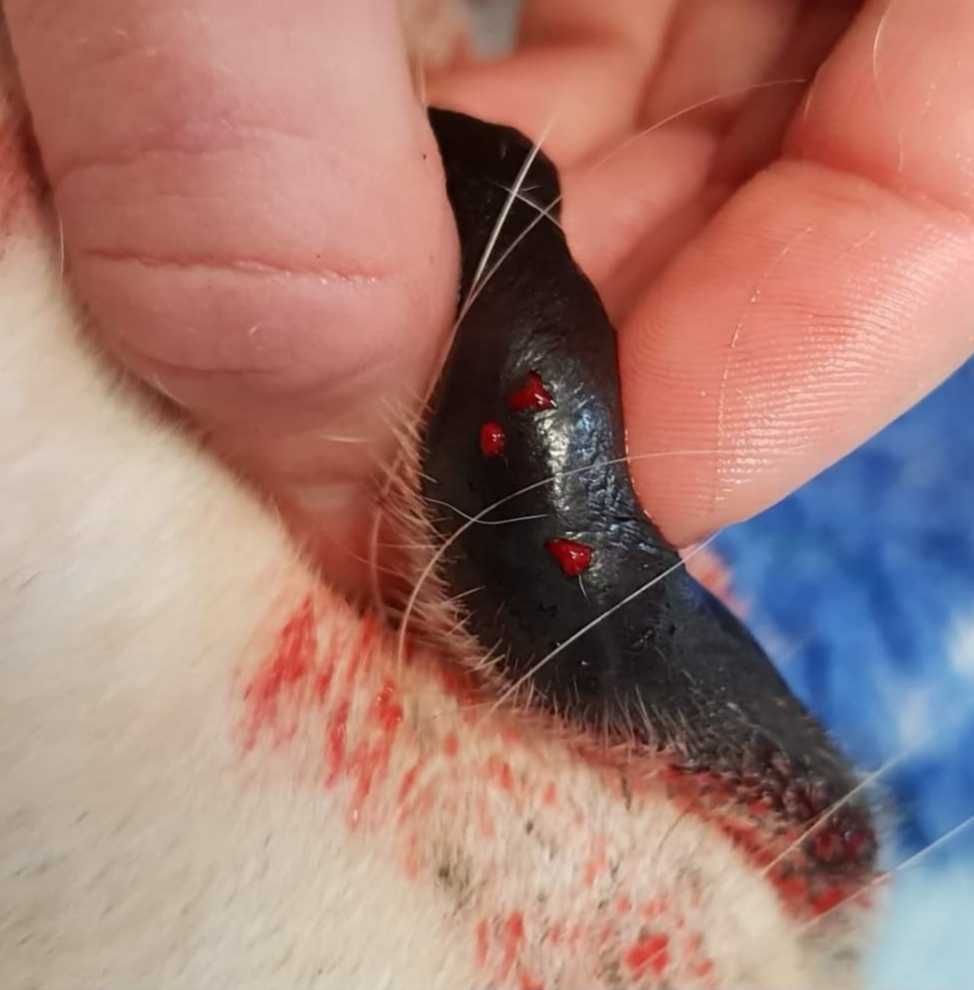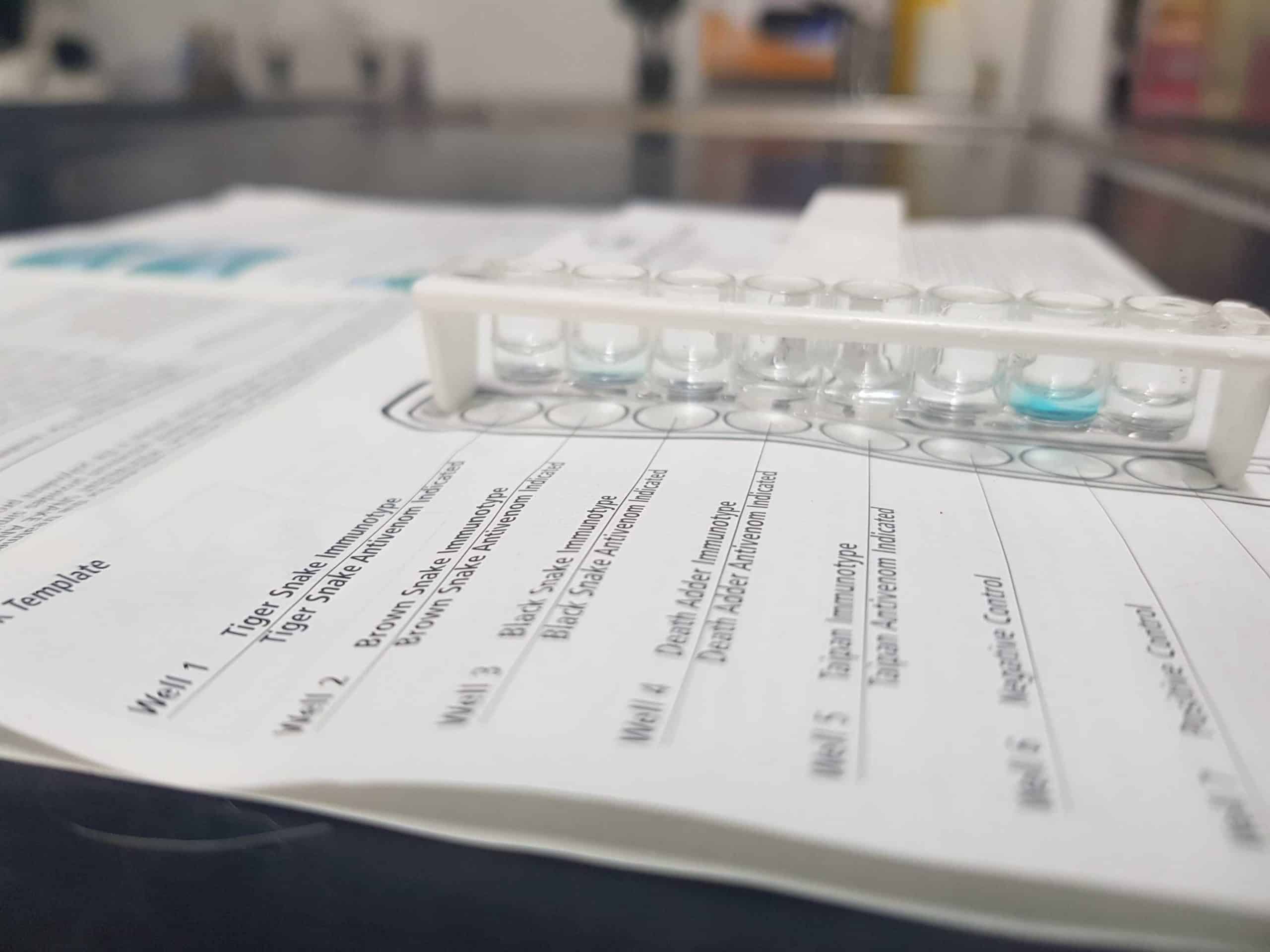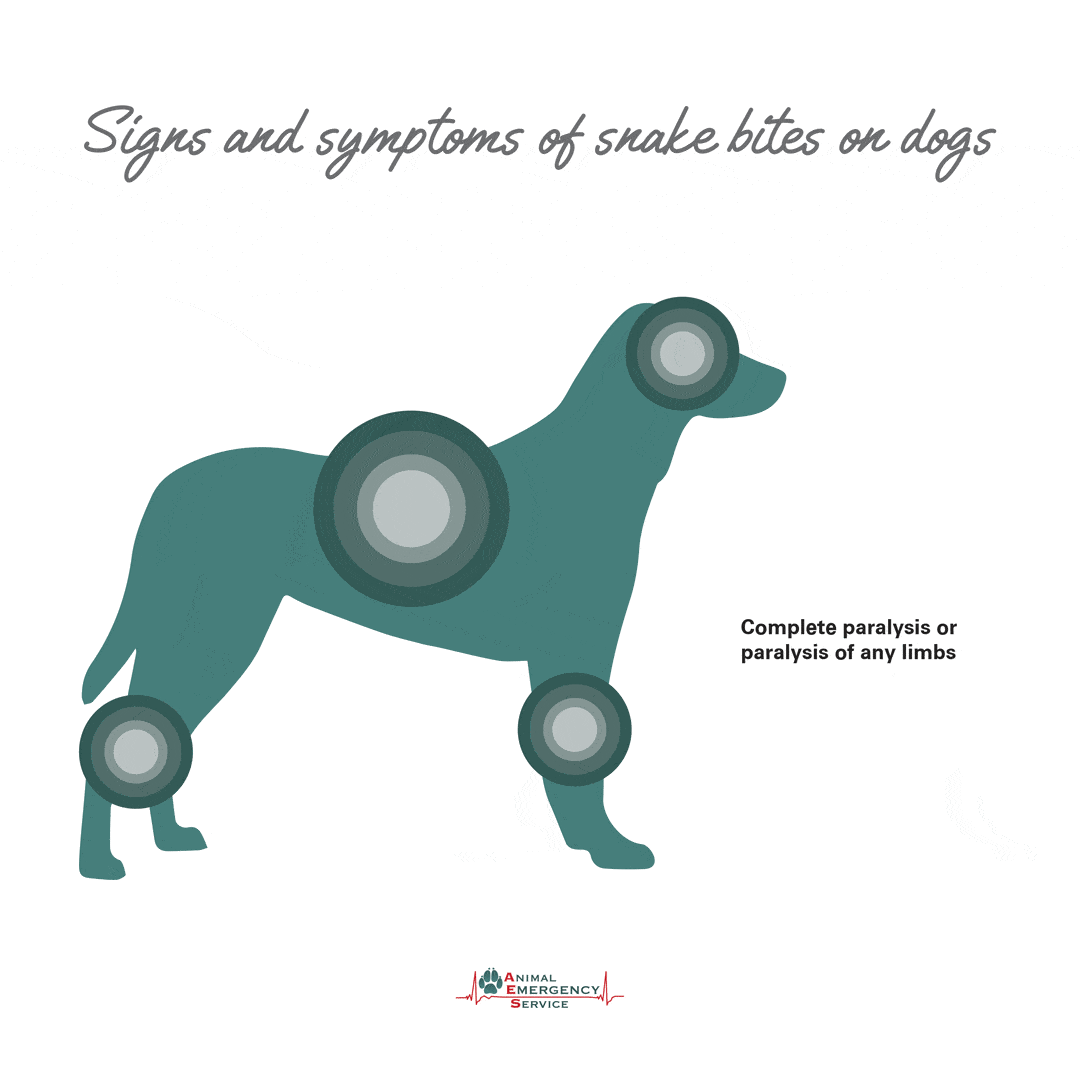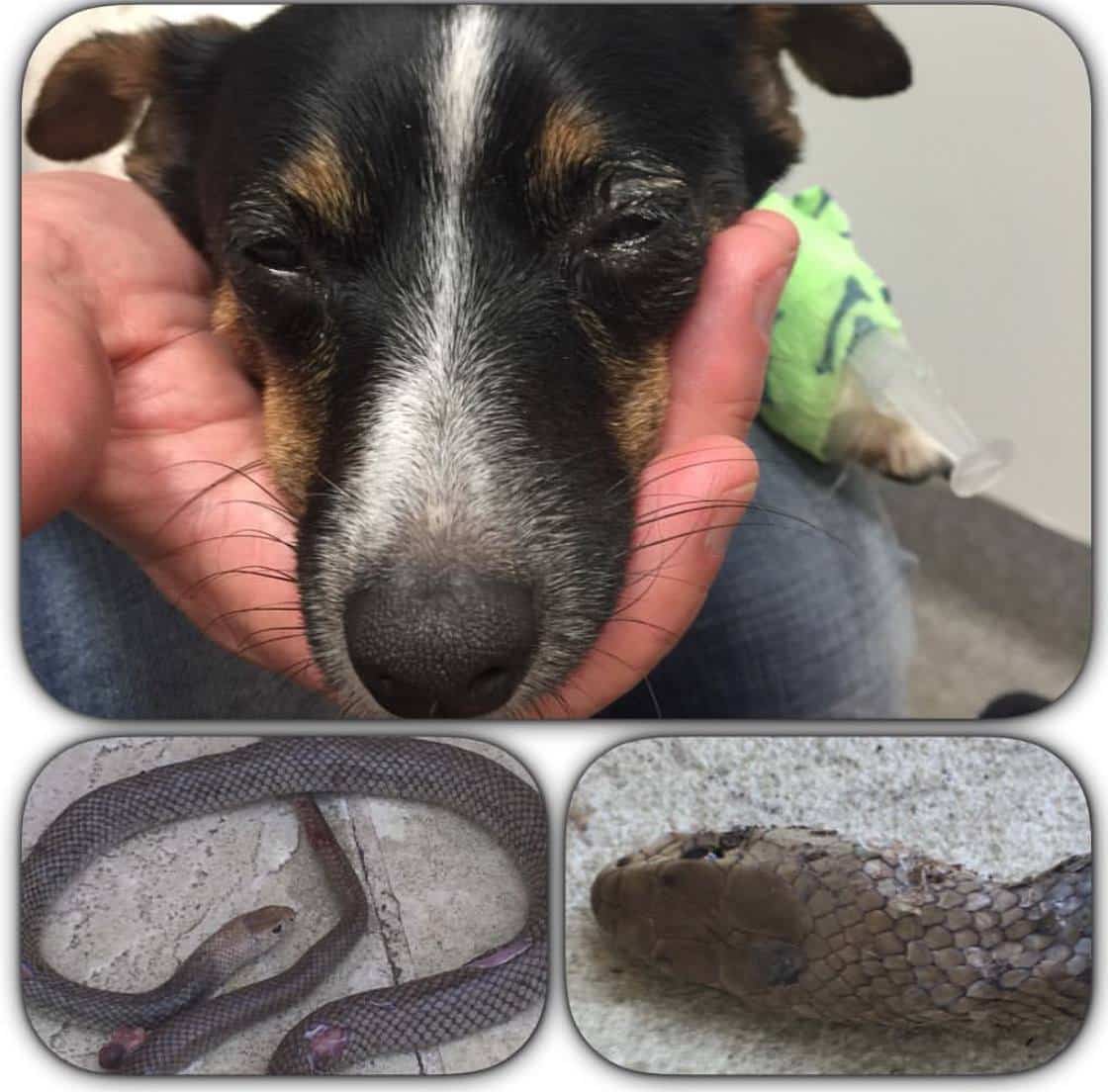Signs and symptoms of snake bites on dogs
Animal Emergency Service treats thousands of cases of dogs who have been bitten by snakes in Australia each year. Although there are subtle differences between the symptoms and signs depending on the breed of snake, the main signs of a dog snake bite include:
- Collapse followed by apparent recovery
- Lethargy
- Muscle tremors, shaking and reduced eye blinking
- Dilated pupils
- Sudden onset of weakness/wobbliness (ataxia)
- Complete paralysis
- Inability to control bladder and bowels
- Irregular bleeding from the nose, bit site, mouth
- Discoloured, dark urine (often bloody)
What you’ll learn
This guide provides information on what to do if your dog is bitten by a snake, the signs and symptoms of snake bites, and is the ultimate guide to snake bites on dogs in Australia.
- What is a snake bite?
- What are the dangers of snake bites in dogs?
- What does a snake bite look like on a dog?
- What are the symptoms and signs of dog snake bites?
- How can I tell if my dog has been bitten by a snake?
- What do I do if my dog is bitten by a snake?
- How do I protect my dog from snake bites?
- How do I treat a snake bite on my dog?
- How will the vet treat my dog for a snake bite?
- How long does it take a snake bite to kill a dog?
- Stories about dogs who have been bitten by snakes
What is a snake bite?
There are many species of snakes in the world, and the most venomous snakes are found right here in Australia. Snakes are unlikely to bite dogs, cats, and humans; however, if they are stepped on, attacked or provoked they may bite, piercing through fur and flesh to deliver often a fatal dose of toxin.
As can be seen by the diagram below, venom is stored in the venom gland. Poisonous snakes use their fangs to bite through their victims’ flesh, and venom travels through the primary and secondary venom ducts down through the venom canal where it is injected into their prey.
Some species of snakes are classified as non-venomous, meaning that other than mild symptoms and site wounds, they are not dangerous to dogs, cats, and humans. These bite wounds may also need attention at your local vet, and regardless of whether you are sure of which breed of snake has bitten your dog, it is always best to seek emergency vet treatment.
What are the dangers of snake bites on dogs?
- Snake bit sites can be difficult to identify on dogs
- Dogs may not show symptoms immediately after being bitten, but may have received a fatal dose of envenomation
- The longer the dog snake bit is left untreated, the more advanced the clinical signs and the lower the chance of survival
- The dangers of snake bites on dogs are high due to their natural hunting instincts
- The only way to identify a snake is to count the scales of the physical snake or perform a snake detection test in clinic
- Not all veterinary practices stock snake anti-venom, it is essential to ring ahead
- Snake venom can compromise the dog’s blood coagulation (clotting) and can cause them to bleed to death
- Snake bites can cause internal damage to kidneys, muscles, and the respiratory system
What does a snake bite look like on a dog?
Snake bites can be difficult to identify, as your dog may not appear to be in pain and the bite wound may be hidden underneath their fur coat. Because snakes have small, razor sharp fangs, the site of the wound may only have faint puncture marks (these could even look like a scratch). It is rare to find the bite site as there may not be a bruise, swelling, or redness, so if you suspect your dog may have been bitten by a snake, it is important to take note of the signs and symptoms of snake bites in dogs.

What are the symptoms and signs of dog snake bites?
If your dog is showing any symptoms or signs listed below, seek emergency vet treatment immediately.
- Collapse followed by apparent recovery
- Lethargy
- Muscle tremors, shaking, and reduced eye blinking
- Dilated pupils
- Sudden onset of weakness/wobbliness (ataxia)
- Complete paralysis
- Inability to control bladder and bowels
- Irregular bleeding from the nose, bite site, mouth
- Discoloured, dark urine (often bloody)
Animal Emergency Service Underwood patient, Bella, is almost completely paralysed after a brown snake bite
A little known symptom of snake bites in dogs, includes an immediate collapsing event followed by apparent recovery and seeming normal. This is a sign that the dog has been given a lethal dose of the venom. For more information about these symptoms and others, read our blog post – What are the symptoms and signs of snake bites on dogs?
How can I tell if my dog has been bitten by a snake?
A dog’s reaction, signs or symptoms from being bitten by a snake can be varied and not appear clinically significant for up to 24 hours after the bite occurs. For this reason, it can be difficult to know if your dog has been the victim of a snake bite. Even the most experienced emergency vet may be unable to tell that your dog has been bitten by a snake based on these symptoms alone, and will need to perform testing with a snake identification kit upon arrival.

If you have witnessed your dog being bitten by a snake, it is important to seek immediate veterinary attention – the longer your dog goes without treatment, the lower the rate of survival. If you have seen your dog playing with a snake, and your dog collapses but then gets up immediately and appears to be fine – call your nearest veterinarian to check if they have snake anti-venom as it is likely your dog has been bitten.
Tony Harrison, a popular Gold Coast Snake catcher, has had his own personal experience – losing two of his beloved dogs to a brown snake. His top 5 tips on looking out for snake activity in your backyard include:
- Noisy birds: heightened bird activity can be associated with snakes
- Dogs barking: excited dogs can be a hint that a snake is present
- Cats stalking: be on the lookout for cats that are stalking ground prey, especially in long grass
- Pet birds: may be agitated in cages and be making a lot of noise
- Dog behaviour: dogs attracted to a particular place in the backyard or clawing at the ground – can indicated cane toads or snakes
What do I do if my dog is bitten by a snake?
Top first aid tips for snake bites on dogs:
- Do not panic, and keep your dog calm
- Seek veterinary assistance immediately
- Phone your local vet and let them know you are on your way (in case they do not stock snake anti-venom they will be able to point you towards a vet that does)
- If it is at all possible, apply a firm bandage above, below, and over the site of the bite (if you know where your dog has been bitten). This assists in stopping the venom from spreading to the heart
- If the bite wound is on the face or neck, remove your dog’s collar as the area may swell
- Attempt to reduce your dog’s movement and activity
What not to do if your dog is bitten by a snake
Snakes only bite when they feel threatened, so don’t attempt to pick up, capture, or kill the snake. If you can identify the breed of snake, make sure to tell your vet, as this will allow them to administer life-saving anti-venom. Try not to over-excite your dog, as this can worsen the effects of the venom due to the adrenaline running through the body. Do not attempt to suck the venom out of the dog’s bite wound – if you have an open wound in your mouth and the venom enters your bloodstream, this could be lethal. Don’t apply a tourniquet, as this stops the supply of fresh blood to the limb causing major health problems (which could include causing the limb to die).
How do I protect my dog from snake bites?
Australia’s climate is the perfect backyard for snakes; particularly in the spring and summer months when the weather heats up. Add to this, Australia has the top ten most venomous snakes in the world.
With the dry and hot conditions prevalent through vast parts of the Australian states, reptiles will seek food sources in places they are not normally found – enter the suburban backyard (porches, empty pot plant pots, sheds, fencing, piles of wood, junk piles and more).
Keeping your pets away from snakes can be difficult, as often you may not be home to monitor them – particularly during the heat of the day. Animal Emergency Service Veterinarian, Dr Courtney Reddrop, offers valuable tips on how to protect your dog from snake bites.
“The most important thing to note is that in protecting your pets from snakes, you must attempt to minimise their known habitats. Keep scrubby and bushy areas cleared and pruned. Remove potential food sources that bring in rodents, as rodents are top food sources for snakes. Mow your lawns, as snakes hide in long grasses which can also make them difficult to see.”
How do I treat a snake bite on my dog?
Five of the top ten deadliest snakes in the world reside right here in Australia, with a population estimated to be approximately 170 species of land snakes and 32 sea snakes. With so many species of snakes, and so many variations of colourings, it can be difficult to identify which snake has bitten your pet. The only way to identify the snake is a scale count of the animal or a snake venom detection kit performed in clinic. It is important therefore, regardless of whether the snake can be identified or not, to seek immediate vet treatment. Note: it is almost impossible to treat snake bites using home treatment.
Anti-venom is the life-saving product administered to pets, and is available at most veterinary clinics and emergency hospitals. Animal Emergency Service has stock of anti-venom at all times, but your local vet may not – so it is important to phone your vet before you visit to ensure they can give your dog appropriate medical care. For more information, read our article: What is the best treatment for snake bites on dogs?
How will the vet treat my dog for a snake bite?
Snake bites are treated as one of the top veterinary emergencies, and it is likely that on arrival your vet will direct you straight through the clinic to receive immediate attention. For this reason, it is always best to ring ahead and let your vet know that your dog has been bitten by a snake; this way they can prepare for your arrival. This means ensuring a snake detection testing kit is on hand, anti-venom, and equipment such as oxygen or a mechanical ventilator (life support) ready to be used if necessary.

Snake venom causes the blood to be unable to clot, therefore the potential to bleed profusely into the chest or via nose and mouth primarily are a concern. This means snake bite victims may also require blood transfusions and other blood products to restore clotting factors and blood cell counts. Although it is common for vets to have emergency blood supply, your dog may require large amounts, so it is always recommended to call your local vet first to make them aware you are on your way. To read more about treatment for snake bites on dogs, visit our article: What is the best treatment for snake bites on dogs?
Sanke anti-venom is administered to Bella at Animal Emergency Service Underwood
The signs and symptoms of snake bites in dogs can become very serious in nature very quickly, it is likely that your dog will require intensive nursing treatment during recovery from snake envenomation. To read more about pet intensive care during recovery, click here.
How long does it take a snake bite to kill a dog?
This question is not a straight-forward one to answer – your dog’s survival rate depends on a number of factors including the type of snake, how much venom has been injected, and the time lapsed between the snake bite and when anti-venom is administered. Each pet responds differently to the venom effects on musculoskeletal and respiratory systems and kidney damage. The most common cause of death from a snake bite is paralysis of the respiratory (breathing) muscles which can happen within 1 hour to 24 hours after the bite. To find out more about how long it takes a snake bite to kill a dog, read this article.
Stories about dogs how have been bitten by snakes
pAnimal Emergency Service is sharing stories about dogs who have been bitten by snakes in order to raise awareness of the signs and symptoms of snake bites. It is hoped that this will prepare owners to keep a look-out for their dogs and watch their body language for signs of being bitten by a snake.p
Tic Tac the dog suffered from an Eastern brown snake bite
Tic Tac the Chihuahua-Maltese X was seen by her owners playing with a snake in the backyard. Worried after Tic Tac collapsed, but then suddenly appeared to be okay when she jumped back up on her feet; they rushed Tic Tac to Animal Emergency Service at Underwood. You can watch her story in the below video, read about her full recovery story here or see the story published by The Courier Mail.
Country music singer Lee Kernaghan’s dog, Princess, bitten by an Eastern brown snake
On October 19, 2015, country music signer Lee Kernaghan’s dog, Princess, was bitten by an Eastern brown snake. He comments on his Facebook post:
“Our little mate “Princess” got bitten by an Eastern Brown snake a few days ago. It was touch and go for a while but it looks like she’s gonna pull through. Mate, we’ve been through thick and thin, the times you’ve saved my skin, and when I needed a friend, you’d jump right in. Thanks to all at Animal Emergency Service.”
See Lee’s original Facebook post.
When work hits home for Gold Coast snake catcher – Tony Harrison
Popular Gold Coast Snake Catcher, Tony Harrison, has filmed this video in the wake of his grief after losing his beloved pets to a brown snake. “While I’m running around saving the rest of the world – my own dogs got killed by a brown snake.”
This is a timely reminder for all pet owners in South East Queensland to be vigilant with their pets while out exploring as well as in their own backyards. Even the professionals aren’t immune to this tragedy as Tony emotionally shows in this video filmed in his Queensland backyard at Yatala.
Please be warned – there are profanities in this video.
Boston vs brown snake
It was a regular day in Bellbowrie while Josh Webber’s two Staffordshire Bull Terriers were chasing his Polaris around the creek – his daily trick to expend the pup’s boundless energy before night time!
At one point Boston took a bit longer to emerge from a garden bed, which was not unusual for this excited and curious puppy. Josh’s mum Joanne describes him as becoming “sooky” and trembling slightly as the night went on, but as he wolfed down dinner as usual and went to bed seemingly fine, no one thought further of it.
Until, at 4:30am Josh awoke to find Boston motionless, unresponsive and drenched in his own urine. This otherwise healthy and energetic dog went downhill rapidly, and his owner’s knew there was something drastically wrong.
Read the rest of Boston’s story.
If your pet has been bitten by a snake or you suspect they have, contact your closest Animal Emergency Service hospital or your local vet immediately.
For more information on what is toxic to pets, visit our Pets and Poisons Guide.




 “The most important thing to note is that in protecting your pets from snakes, you must attempt to minimise their known habitats. Keep scrubby and bushy areas cleared and pruned. Remove potential food sources that bring in rodents, as rodents are top food sources for snakes. Mow your lawns, as snakes hide in long grasses which can also make them difficult to see.”
“The most important thing to note is that in protecting your pets from snakes, you must attempt to minimise their known habitats. Keep scrubby and bushy areas cleared and pruned. Remove potential food sources that bring in rodents, as rodents are top food sources for snakes. Mow your lawns, as snakes hide in long grasses which can also make them difficult to see.”
